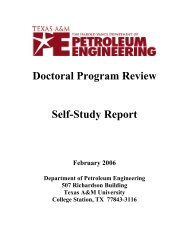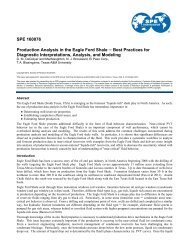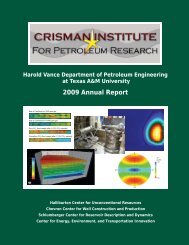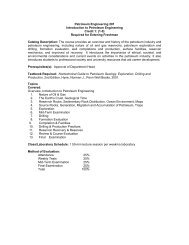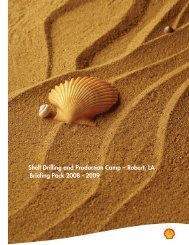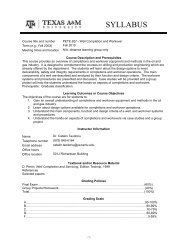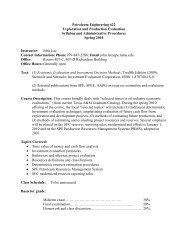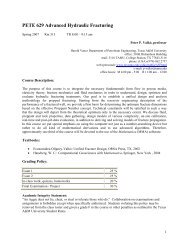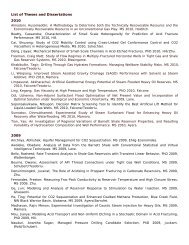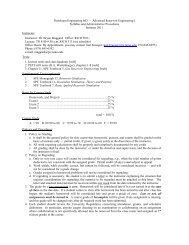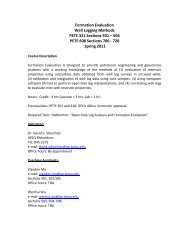Nontechnical Guide to Petroleum Geology, Exploration
Nontechnical Guide to Petroleum Geology, Exploration
Nontechnical Guide to Petroleum Geology, Exploration
You also want an ePaper? Increase the reach of your titles
YUMPU automatically turns print PDFs into web optimized ePapers that Google loves.
<strong>Petroleum</strong> Engineering 322<br />
Geostatistics<br />
Credit 3: (3-0)<br />
Catalog Description<br />
Introduction <strong>to</strong> geostatistics; basic concepts in probability and univariate statistics; bivariate statistics and<br />
spatial relationship; covariance and correlation; second order stationarity; variogram estimation and<br />
modeling; spatial estimation and reservoir modeling; simple and ordinary kriging; uncertainty analysis;<br />
estimation versus conditional simulation; sequential Gaussian simulation.<br />
Prerequisites<br />
Instruc<strong>to</strong>rs Permission.<br />
Section 501 Section 502<br />
Instruc<strong>to</strong>r<br />
Instruc<strong>to</strong>r<br />
Akhil Datta-Gupta<br />
Behnam Jafarpour<br />
Office: Richardson 401D<br />
Office: Richardson 401F<br />
E-mail: datta-gupta@pe.tamu.edu<br />
E-mail: behnam@pe.tamu.edu<br />
Office Hours:<br />
Office Tues/Thurs 3:00-4:00PM<br />
Text Book<br />
Kelkar M., Perez G., (2002): Applied Geostatistics for Reservoir Characterization. Society of <strong>Petroleum</strong><br />
Engineers, Texas.<br />
Topics Covered<br />
1. Introduction <strong>to</strong> Geostatistics and Spatial Modeling<br />
2. Review of Probability and Statistics;<br />
3. Univariate Distributions (PDF and CDF); Statistical Measures; Statistical Moments and<br />
Expectations; Properties of Moments and Expectations<br />
4. Common PDFs; Normal Distribution; Properties of Normal PDF and Test of Normality;<br />
Log-Normal Distribution<br />
5. Probability Mapping and CDF Transformation; Normal Score Transform; Monte Carlo<br />
Method;<br />
6. Bivariate Analysis (Joint Distributions); Covariance and Correlation; Joint Normal<br />
Distribution<br />
7. Linear Regression & Least-Squares; Estima<strong>to</strong>rs and Their Properties; Residual<br />
Analysis and Coefficients of Determination<br />
8. Confidence Intervals; t-Student-test and F-test;<br />
9. Spatial Relationships and Basic Concepts; Stationarity, Au<strong>to</strong>covariance, and<br />
Au<strong>to</strong>correlation<br />
10. Stationarity; Variograms Estimation and Variograms;<br />
11. Modeling Geological Media; Linear Interpolation (Kriging);<br />
12. Simple Kriging; Ordinary Kriging; and Universal Kriging<br />
13. Estimation versus Simulation; Sequential Gaussian Simulation<br />
Lectures<br />
This course will have three 50 minute lectures per week.<br />
Homework<br />
There will be a <strong>to</strong>tal of 8 homeworks that account for 20% of the final grade. Some of the problem sets may<br />
involve use of computers and geostatistical software <strong>to</strong> help you explore different aspects of the material.<br />
You can use any geostatistical software of your choice <strong>to</strong> do those problem sets. A few general software<br />
packages that can be used for this purpose are GEOEAS, GSLIB, and SGeMS. An introduction <strong>to</strong> one of<br />
1



